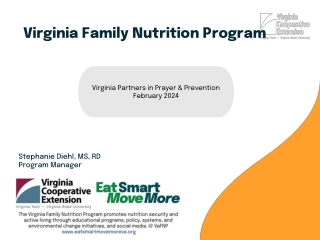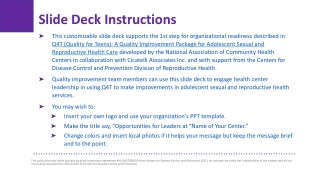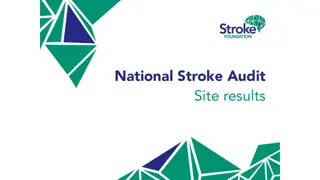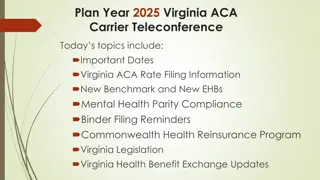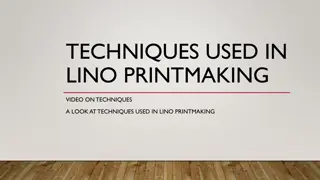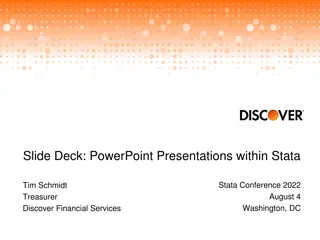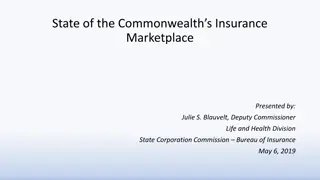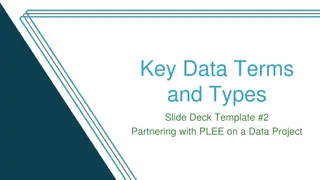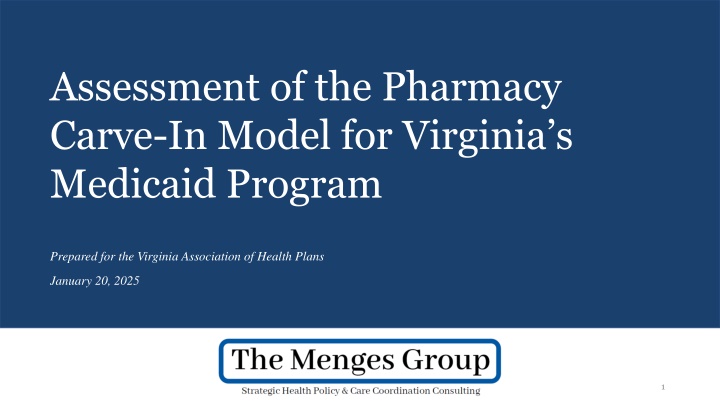
Assessment of Virginia's Medicaid Pharmacy Carve-In Model
Explore the assessment conducted for Virginia's Medicaid program, comparing the current pharmacy carve-in model with a potential carve-out model. The assessment addresses the fiscal and programmatic impacts of switching models and evaluates the advantages and disadvantages. Key considerations include the pharmacy rebate dynamics, annual cost impact on state funds, and the implications on drug mix, rebates, payments, and administrative costs.
Download Presentation

Please find below an Image/Link to download the presentation.
The content on the website is provided AS IS for your information and personal use only. It may not be sold, licensed, or shared on other websites without obtaining consent from the author. If you encounter any issues during the download, it is possible that the publisher has removed the file from their server.
You are allowed to download the files provided on this website for personal or commercial use, subject to the condition that they are used lawfully. All files are the property of their respective owners.
The content on the website is provided AS IS for your information and personal use only. It may not be sold, licensed, or shared on other websites without obtaining consent from the author.
E N D
Presentation Transcript
Assessment of the Pharmacy Carve-In Model for Virginia s Medicaid Program Prepared for the Virginia Association of Health Plans January 20, 2025 1
Introduction Current approach: Virginia s Medicaid Managed Care Organizations (MCOs) coordinate and pay for more than 99% of the prescription drugs utilized by the Commonwealth s Medicaid enrollees. This approach is often referred to as a pharmacy carve-in. Potential shift: Over the last few years, some Virginia stakeholders have indicated an interest in moving to a Medicaid pharmacy carve-out, whereby the Commonwealth would instead manage the pharmacy benefit, creating a single-payer system for retail pharmacies using Medicaid s fee-for-service payment methodology. The assessment: Virginia s Association of Health Plans engaged The Menges Group to assess the fiscal and programmatic impacts of switching to a carve-out model, including identifying the advantages and disadvantages of the two models. 2
Current Pharmacy Rebate Dynamics DMAS implemented a Common Core Formulary across all Medicaid programs by 2018, steering drug usage to those with the lowest net (post- rebate) cost through Medicaid managed care contracts that hold MCOs responsible for timely encounter submissions. Through the American Rescue Plan Act (ARPA) of 2021, from January 2024 forward, the 100% rebate cap is no longer in effect, meaning that a pharmacy rebate could be greater than the initial cost of the drug making some drugs better than free to the Medicaid program. Evolving brand drug prices and rebates are disrupting the traditional MCO model of steering usage toward drugs with the lowest net cost to MCOs, as the lowest-cost drug from an MCO's perspective is often different from the lowest net cost for Medicaid, as the federal statutory rebates are paid to the government and do not in any way flow to or through MCOs. While other states may need to implement a preferred drug list to get MCOs to drive usage to high-rebate drugs, DMAS is already well- positioned to steer prescription volume to the lowest net-cost drugs while minimizing financial risk from high-cost specialty drugs (and allowing MCOs to integrate the drug benefit and drug data with all other health services). This structure constitutes a win-win scenario. 3
Annual Cost Impact of a Carve-Out, State Funds The net cost impact of a pharmacy carve-out is an annual state fund cost increase of $44 million. Our cost impact was determined through an assessment of the following components, which is described in more detail on the next slide: Drug mix and drug rebates Initial (pre-rebate) pharmacy payments Risk margin payments Administrative cost impacts 340B program impacts 4
Cost Impact of a Carve-Out, cont. Drug mix and drug rebates: Because of the mature existence of the Common Core Formulary, we expect that the drug mix, and therefore the associated rebates, would not be meaningfully different under a carve-in or carve-out model going forward. Initial (pre-rebate) pharmacy payments: Each MCO pays pharmacies based on negotiated contracts. However, under a carve-out, the Actual Acquisition Cost payment model would be required of DMAS, which creates favorable pricing on ingredients but involves a far higher dispensing fee ($10.65). One of the Virginia MCOs modeled that a carve-out would increase annual pharmacy payments for their enrollees by over $10 million, which extrapolates to $152 million if applied across all MCO Medallion 4 enrollees.The Commonwealth s share of this is anticipated to be 25% of the overall Medicaid cost increase, or $38 million. Risk margin payments: MCOs are compensated for bearing the full risk of health care costs. A pharmacy carve-out would reduce the financial risk that health plans face, thereby reducing the amount of risk margin compensation needed in the MCO capitation rates. We estimate that the Commonwealth would save an estimated $11.3 million annually from the loss of pharmacy risk margins in a carve-out but would lose budget reliability by taking on the risk of price increases. 5
Cost Impact of a Carve-Out, cont. Administrative cost impacts: Under a carve-out, the administrative functions that currently occur, such as pharmacy claims processing, prior authorizations, and member and provider calls, will transition to DMAS and/or its contractor(s). What would change administratively under the carve-out is the lower federal match rate for the new administrative duties that DMAS takes on, resulting in an estimated $17 million loss of federal matching funds for Virginia. 340B program impacts: Under a carve-out, DMAS could potentially take for itself the savings that Virginia s FQHCs currently derive through their participation in the 340B program, which provides discounted drugs to FQHCs. These savings would, however, come directly at the cost of impairing the FQHCs ability to fulfill their mission. A State Plan Amendment mechanism exists to keep FQHCs whole if a carve- out were to be implemented. We have not modeled savings within the 340B program, as we presume that the Commonwealth will not seek savings from its own safety net system. 6
Capitation Rate-Setting Issues Virginia s MCOs have had a successful partnership with DMAS and its actuarial contractor, Mercer. Notwithstanding the favorable overall history, the MCOs have viewed the pharmacy component of the capitation rate as underfunded for multiple years and are concerned that the cost dynamics of this component may warrant some methodological revisions due to: Eligibility changes: Medicaid eligibility unwinding has led to a disproportionate loss of coverage for individuals with low/no prescription drug use. The remaining beneficiaries have higher pharmacy costs, which should be accounted for in the capitation rate. Rising drug costs: In 2014, drugs costing over $1,000 per prescription accounted for 32% of Medicaid pharmacy pre-rebate spending. This share increased to 63% in 2024. Additionally, the rising popularity of and need for high- cost drugs, such as GLP-1 weight loss drugs, create the potential for enormous new costs to emerge. Better-than-free drugs: Brand-name drug manufacturers reactions to some of their drugs now being better than free when used in Medicaid are difficult to predict. While the pharmacy arena poses particular capitation rate-setting challenges, carving in the drug benefit is valuable to DMAS in creating budget predictability. 7
Implementation Risks of Moving to a New Model The shift from an integrated carve-in model to a carve-out model for Medicaid pharmacy benefits introduces significant implementation risks, as seen in states that recently implemented this transition. California (2022): The carve-out immediately led to disturbing access issues, such as long wait times and delayed prior authorizations, causing a dramatic drop in prescription fulfillment (8.3 million less than were occurring under the carve-in model). The diminished access included important maintenance medications such as insulin. Although California relaxed prior authorization and other cost containment measures to restore access, this resulted in a substantial increase in net prescription costs ($2.07 billion more than the prior year). Kentucky (2022): Wrongfully, dual eligible members had to pay copays on Medicare Part B covered products (e.g., diabetic supplies). Additionally, coordination of benefits (COB) rejections occurred at such a high rate that the State s PBM needed to turn off all the COB-related point-of-service rejections. Mississippi (2024): TheState sPBM turned off prescriber edits, due to the credentialing deadline occurring the same day as the carve-out transition. Uncertainties arose regarding whether certain drug claims should be processed under the medical or pharmacy benefit. New York (2023): The carve-out led to some fragmentation in care, with long wait times due to the Medicaid agency s limited hours of operation, and some providers being unaware that physician-administered medications are not covered under the pharmacy benefit. 8
Quality Comparison of Carve-In and Carve-Out Approaches National and regional analyses indicate that the carve-in model leads to superior quality scores in Medicaid compared to the carve-out model. National: A 2023 Elevance Public Policy Institute report found that the fully MCO-managed model outperformed the FFS model in 97% of HEDIS score large group comparisons Regional: The above-referenced study compared HEDIS scores in three carve-out states (Missouri, Tennessee, and Wisconsin), with all of their neighboring carve-in states and found average scores to consistently be superior in the adjacent carve-in states (relative to the region s carve-out state). Also, during both 2022 and 2023, Virginia s MCOs had better HEDIS scores than the collective average of its neighboring states across 28 pharmacy-related quality measures. 9
Data Integration in Carve-In and Carve-Out Settings Real-time data access: In a carve-in, prescription drug data are immediately available and integrated with MCO systems for efficient care coordination. A carve-out delays data access and decreases data compatibility, reducing an MCO s ability to respond to pharmacy-related issues in real time. Communication efficiency: The carve-out model can lead to communication breakdowns between members, providers, and MCOs, leading to fragmented care, delays in medication access, and confusion over responsibility for care. Swift intervention: Real-time pharmacy data is crucial for care managers to effectively address medication issues, monitor adherence, and coordinate care, specifically for those with complex conditions. This ensures timely interventions and adherence to personalized treatment plans. 10
Access and Adherence Advantages of Carve-In Model Virginia's Medicaid MCOs use a range of strategies to support medication access and adherence for members, including: Proactive adherence calls to ensure uninterrupted prescription access IT systems to identify barriers to prescription refills or missing but seemingly necessary prescriptions Longer days-supply of medications and override support, if needed Condition-specific outreach and education (for example, for asthma and Medication-Assisted Treatment) Collaborative efforts between care managers and pharmacists to assist with post-discharge transitions and complex treatments Lessened requirements on authorizations and reporting during natural disasters 11
Case Examples of MCOs Going the Extra Mile Case Example 1: Supporting An Enrollee Through an Out-Of-State Emergency In early 2024, a Virginia member was flown to the Cleveland Clinic for a cardiac procedure and was scheduled to fly back late on Friday. Unfortunately, inclement weather canceled the flight, so this patient was suddenly and unexpectedly stranded in Cleveland until another flight could be scheduled. As a result, the care management team was pulled in to find a hotel for at least one night as well as transportation. Early on Saturday, the pharmacy team received a call from care coordinators indicating that the member was high acuity and out of multiple medications. The pharmacy director immediately contacted the PBM to (1) locate pharmacies near the hotel, (2) engage with pharmacies about the targeted medications to ensure they had adequate supplies, and (3) grant early-refill overrides for these medications. The care management team then supplied transportation to get the patient to the pharmacy as well as meal coordination and arranged an alternate flight back to Virginia. 12
Case Examples of MCOs Going the Extra Mile (continued) Case Example 2: Addressing Member Needs When a Drug is Discontinued Earlier this year, Relyvrio, a medication used to treat amyotrophic lateral sclerosis (ALS), was discontinued following reports from Amylyx that the drug failed to provide clinical benefits. For members who were currently on Relyvrio, ensuring continuity of care was crucial due to the debilitating nature of ALS. Our MCO took a proactive approach by reviewing the utilization of Relyvrio among our members. We reached out to the prescribing physicians to assess their plans for transitioning to alternative treatments based on this new information. Our pharmacy team worked closely with both the prescribing physicians and pharmacies to expedite the authorization process for new medications. This ensured that there were no delays in getting the necessary approvals and that members received their new treatments promptly. Examples of such comprehensive support and coordination may be challenging to achieve in a carve-out setting, where fragmented care management can hinder timely and effective responses to significant changes in medication availability. 13
Recommendations 1) Preserve the current carve-in pharmacy model for the Medicaid program, avoiding fragmentation in care and averting an adverse estimated annual state fund impact of $44 million. 2) Preserve the Common Core Formulary, helping reduce overall program costs. 3) Enhance MCO reimbursements to critical access pharmacies. 4) Increase MCO policymaking representation on the Drug Utilization Review Board Committee and the Pharmacy and Therapeutics Committee. 5) Consider capitation rate-setting revisions for the pharmacy component. The carve-in model is financially advantageous to the Commonwealth in that it preserves and encourages the whole person care model for managed Medicaid that is gaining traction throughout the US. This model allows for the coordinated treatment of the individual, evaluated through coordinated real time data and a care team to reconcile and manage all aspects of the member s care. This model enhances the right care, in the right place, at the right time model that has been most effective in controlling both quality and cost. Virginia MCO Pharmacy Executive 14

